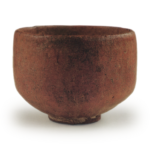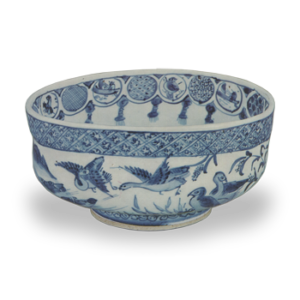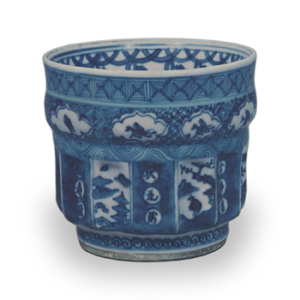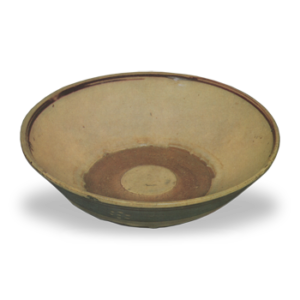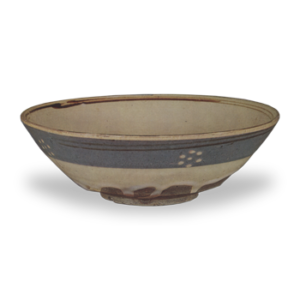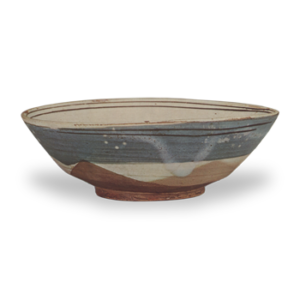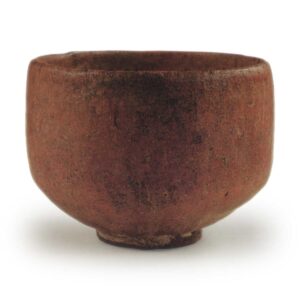
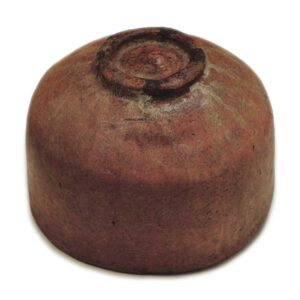
Chuko Meibutsu
Important Cultural Property
Height: 8.3-8.5cm
Diameter: 10.8-11.2cm
Outer diameter of foot ring: 4.8cm
Height of foot ring: 0.6cm
On the inside of the lid of the box, the words “Muichimono” are written in ink by the hand of Kosomuro, or Senso, but it is not clear whether this was Senso’s own inscription or whether he simply wrote on the box an inscription that had already been there. However, the name “Muichimono” (meaning “having nothing”) is very apt for this tea bowl, and its calm and stable appearance is truly befitting of the Zen term “Muichimono”.
The shape of the tea bowl is typical of the style favored by Rikyu, and it is thought to have been made around the year 1587, and is probably one of the early Sōetsu-style Chōjirō tea bowls.
The slightly inward-turned rim, the plump body, and the gently tapering curve from the waist to the foot are all completely unadorned.
The foot is slightly smaller than the diameter of the bowl, and has also been gently carved out, but the inside of the foot is clearly and spirally raised, just like Daikoku.
The reason for this is unclear. The Daikoku is also quite thick, but in the case of this tea bowl, it is somewhat of an exception, or it seems as if the clay was added to the inside of the bottom after it had been scraped down once. The clay is a fine sandy clay called Juraku-do, and it has a strong reddish hue.
In general, it has been glazed with a transparent glaze and fired, but the glaze is thin and the firing temperature was probably low, so the glaze has almost completely worn off and is only thinly attached to the clay surface.
In particular, the inside has completely flaked off, revealing the red clay body. However, the inside has relatively well-preserved, and there are also glaze pools inside and outside the foot ring, and the glaze has also flaked off white.
The foot ring is attached, and about half of the unglazed clay is exposed. This is unusual for a Chojiro tea bowl, and there are five clear traces of the marks left by the potter’s fingers. Jirobo is the closest in terms of both clay and glaze, but the workmanship is slightly different.
The origin of the tea bowl in the early Edo period is unknown, but it later came into the possession of Kyoto tea master Shimizu Totaro, and in the first year of the Kyōwa era (1801), it is said to have come into the possession of the tea master Matsudaira Fumai through the intermediary of the dealer Takeya Chubei, and is recorded in the Unshū Meibutsu Ki (Famous Things of Unshū) as a famous tea bowl from the Chūkō era, with the name Chōjirō Akamono Ichimono Kyōshimizu Totaro Kyōwa Takechū Gohyaku ryō. However, in the “Osaki-sama Gidōdai Otomehiki” (a record of the expenses of the Osaki family), it is written “Muichimono Kirihachi (Kirihachiya Hachizaemon) 364 ryō Chūkō (Chūkō meibutsu)”, and it is thought that the description in the Otomehiki may be more accurate.
According to the “Fumai-ko Chakai-ki” (Fumai’s Tea Gathering Diary), in the winter of the second year of the Kyowa era, he used this tea bowl at a tea gathering, and the main combination of items was a tea caddy with a poem by the poet Fujiwara no Teika, a tea bowl with a design by Toshige, a tea bowl by Chojiro, and a tea bowl with a design by Sekisō, which is a very evocative combination, and it shows the elegance that is unique to Fumai.

